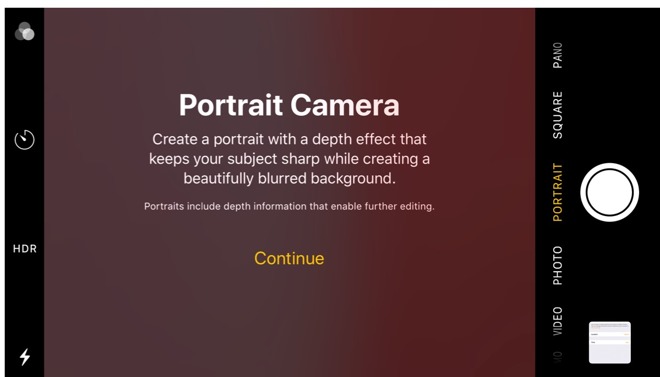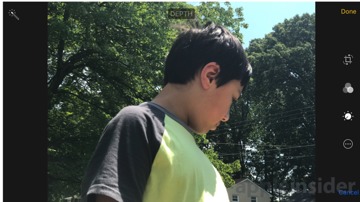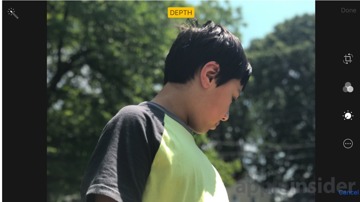Inside iOS 11: Apple's Portrait Mode in iPhone 7 Plus exits beta, allows effect to be turn...
In the latest iOS 11 beta, Apple has taken the Portrait Mode camera setting out of beta, and has altered how the camera roll handles the pictures to allow for the effect to be removed from a picture with it at any time.

First pointed out by ThinkApple, Portrait Mode not only has exited its beta status, but has seen some improvements as well. The procedure to take the shot is unmodified, but the Edit feature now allows for the effect to be removed at will, and non-destructively.
The effect still can't be applied retroactively if the image wasn't taken in Portrait Mode to begin with.
Apple's Portrait mode takes advantage of the twin cameras on the iPhone 7 Plus, using them to gauge the depth of a scene and blur the background. Apple announced the mode when it revealed the phone on September 7, but said it would only be available in a later software update.
The feature shipped with iOS 10.1 in beta mode on October 24. Apple made the feature the centrepoint of its "Shot on iPhone" advertising campaign, with several ads demonstrating it.
The ability to retain data about the picture, and still save space versus iOS 10 and earlier versions of the operating system are made possible by the addition of HEIC. The 2017 WWDC keynote saw the debut of HEIC for images, and HEVC for video in iOS 11.
For more on Apple's forthcoming operating system update, see AppleInsider's ongoing Inside iOS 11 series

First pointed out by ThinkApple, Portrait Mode not only has exited its beta status, but has seen some improvements as well. The procedure to take the shot is unmodified, but the Edit feature now allows for the effect to be removed at will, and non-destructively.
The effect still can't be applied retroactively if the image wasn't taken in Portrait Mode to begin with.
Apple's Portrait mode takes advantage of the twin cameras on the iPhone 7 Plus, using them to gauge the depth of a scene and blur the background. Apple announced the mode when it revealed the phone on September 7, but said it would only be available in a later software update.
The feature shipped with iOS 10.1 in beta mode on October 24. Apple made the feature the centrepoint of its "Shot on iPhone" advertising campaign, with several ads demonstrating it.
The ability to retain data about the picture, and still save space versus iOS 10 and earlier versions of the operating system are made possible by the addition of HEIC. The 2017 WWDC keynote saw the debut of HEIC for images, and HEVC for video in iOS 11.
For more on Apple's forthcoming operating system update, see AppleInsider's ongoing Inside iOS 11 series



Comments
the front camera is a “selfie” camera. Big difference.
I’m not sure if it contains the entire picture, the background, or just the mathematical convolution of the background. Until we know which, we can’t say how much space it takes.
facial recognition can’t do those sort of calculations because the scene is viewed, and imaged, from one camera, from one point. If IR is used. Or a laser, it isn’t used in the same manner as a different lens. It’s hard to explain it all here.
so another photography term that’s abused, to my way of thinking, is the term “prime lens”. When I started out in photography, as a kid, in the early mid 1960s, prime lenses were called that because they were the lenses that came with the camera, and thus, were the first, and most used lens, earning the term “prime”. This lens was almost always something between 50 to 58mm, depending on how old the design was, the 58mm Biogons being the oldest designs.
back then there were no real zooms. Zooms were very hard to make, and the few that were out there were pretty bad. The first high quality zoom came a bit later, and was the Canon Pro 80-200 f2.8. In its day, it was a great lens, expensive, but not atrociously so. It became a popular Pro lens when ultimate quality wasn’t needed. After that, we began to see more zooms.
but they were still heavy, big, and pretty expensive, until again, Canon led the way with the first variable max f stop. So, that allowed zooms to have say, f3.5 at the widest, and maybe an f5.6 at the longest. That lowered the size, weight, and most importantly, the price. It opened up zooms for everyone. Generally only Pro zooms have a fixed max f stop today.
sometime after that, I found people writing about prime 100mm lenses, and prime 200mm lenses, and prime 24mm lenses, etc. The change in the term had begun. Now, any lens that’s not a zoom is a prime. I still don’t like it, but that’s what it is.